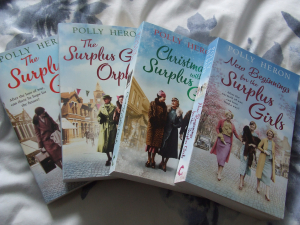One question I get asked a lot is how I tackle writing a series.
I have three of them on the go now...

The Railway Girls, written as Maisie Thomas, my Second World War series
about the brave women and girls who worked on Britian's Railways
 | The Surplus Girls, written as Polly Heron, my 1920 saga series about young women striving for independence after the Great war |
....and my new WW2 series, The Home Front Girls, written as Susanna Bavin, which will see the light of day in 2024, when the first three titles will be published.
So how do I go about writing a series? If you're thinking of writing one yourself, here are my three top tips to help you along the way:
1. What is going to link the books together within the series?
The characters? The setting? A continuing plot?
If you have a continuing plot, don't forget that each title also has to be complete in itself. Each Surplus Girls book has a new heroine and the main plot belongs to her, but what Belinda, Molly, Nancy and Jess have in common is that they all attend a secretarial school run by two spinster sisters, Prudence and Patience Hesketh. The Hesketh sisters have a continuing story that moves on from one book to the next - but each part of their story feels complete within each book.
In my Railway Girls series, all the girls feature in each story, though only three of them are viewpoint characters in each book. Continuity comes from the familiar characters, the wartime setting and also certain plot-lines that take place because of something that happened in an earlier book. Anyone who has read Hope for the Railway Girls (book 5) is going to intrigued and possibly even shocked by how events unfold in the forthcoming book 8, Christmas Wishes for the Railway Girls.
In my new Home Front Girls series, one of the continuing features is the characters' place of work. I don't want to give away any spoilers but another continuing feature is attitudes to the work they girls do - both their own attitudes and other people's.
h
2. There's no such thing as too much planning!
For me, it's all in the planning. The Surplus Girls series started life as a 24-page synopsis of the first three books. This was the perfect foundation to build on. It also gave me the chance to link the books together right at the outset. For example, a small incident in the first book, The Surplus Girls, which seems to be there simply to highlight a particular aspect of someone’s personality, turns out to be a major plot-point in book 3, Christmas with the Surplus Girls. The more you sort out in advance, the richer the series will be.
3. Keep detailed information.
- I keep information about each character – physical description, family details, also their clothes. I write about the 1920s and the 1940s and people back then didn’t have anything like so many clothes as we do now, so I like to reflect that.
- I also have a chapter-by-chapter outline of every book, complete with dates. Even though the dates ares seldom mentioned in the narrative, I know the date on which every scene takes place.
- You'll soon learn which information you need to record. Don't put off doing it!
So there we have my three top tips for writing a series.
And if you'd like to know how I tackle each individual book, please take a look at this blog from April 2022 in which I share my 12-step plan for planning a book.
Good luck with your series! xx
* * * *
Link to The Surplus Girls series on Amazon
Link to The Railway Girls series on Amazon
Link to my Susanna Bavin sagas on Amazon (NB The Home Front Girls series won't be available until 2024.)


Make A Comment
Comments (0)